
TẠP CHÍ KHOA HỌC - ĐẠI HỌC ĐỒNG NAI, SỐ 08 - 2018 ISSN 2354-1482
15
DETERMINANT OF THE FACTORS INFLUENCING TAX
COMPLIANCE OF ENTERPRISES IN DONG NAI PROVINCE
Nguyễn Thị Lý1
Trà Văn Trung2
ABSTRACT
Vietnam tax industry has carried out a new tax management mechanism which is
tax self-declaration and self-payment. With this mechanism, tax payers self-declare
their taxes, self-calculate their tax payables and self-pay their taxation to the state
budget. However, for different reasons, tax payers do not always declare and pay
their tax payables exactly, fully and punctually. Tax organizations in Vietnam in
general and Dong Nai province in particular need to inspect and find these causes.
The aim of this research is not only to find out the groups of factors which influence
the tax compliance of enterprises in Dong Nai province but also to propose
recommendations to improve the tax collection in Dong Nai province. Through the
analysis of the qualititive and quantitive, the research shows that there are five
factor groups affecting the tax compliance of tax payers, including Economics,
Taxation policy, Law and society, Tax management and Psychology. At the same
time, the findings also help motivate tax payers to do their tax responsibilities
voluntarily as well as help Dong Nai tax agencies give better solutions to attracting
more FDI and new investments in the future.
Keywords: Tax; tax payer; tax management; tax payment; Dong Nai
1. Introduction
Like many developing countries in
the world, Vietnam is now facing many
different challenges in tax management,
which are: how to limit the loss of tax
collection source and how to improve the
awareness of tax compliance of
enterprises. Actually, the tax compliance
at the low rate greatly affectseconomic
growth and development of a country.
With the current management mechanism
in Vietnam, tax declaration and payment
are to increase initiatives and make
companies and individuals more
responsible for their tax duties.
Taxdeclaration and payment must be in
the tax management mechanism, and tax
payers have to be motivated and self-
aware of their duties according to the tax
law. Therefore, tax payers will declare
taxes, count taxes, pay taxes punctually
according to the law and take
responsibility for their tax declaration and
payment. Tax managing organizations
will not directly interfere in declaration,
payment of tax payers except finding out
errors relevant to the tax law breach or
evidence of not obeying the tax law.
However, in case tax payers’ tax
compliance is negative, managing ability
of tax organization is less relevant, or tax
payers’ tax fraudulent behavior can not
1Trường Đại học Đồng Nai
Email: lynt2005@gmail.com
2Trường Đại học Kinh tế - Luật TP. Hồ Chí Minh

TẠP CHÍ KHOA HỌC - ĐẠI HỌC ĐỒNG NAI, SỐ 08 - 2018 ISSN 2354-1482
16
be discovered, tax declaration and
payment will not bring any results.
Therefore, the most important functions
of the tax organizationare checking and
controlling tax payers’ tax law obedience.
However, the tax management in
Vietnam is still limited, which leads to
the low effect of management and big tax
losses in many fields.
Dong Nai province is located in the
center of the key economic area in the
Southern Vietnam with 33 industrial
zones, attracting a lot of foreign
investments. According to statistics,
until June 2017, FDI enterprises have
contributed more than 45% GDP to the
province. FDI enterprises in Dong Nai
use highly-standardised technology to
provide employment for laborers,
create competitive capacity for them in
technology transfer and management
methods as well as give considerable
contributions to the increase of the
local budget.
In the tax management, Dong Nai
has carried out the mechanism which is
that tax payers must declare taxes,
count tax payment and pay taxes to the
state budget by themselves. Tax payers
have to be responsible for implementing
their tax payment duty legally.
However, with many different reasons,
tax payers do not always declare their
taxes exactly and pay sufficiently, on
time with their amount of tax payment.
Every behavior of tax payers’ tax
law incompliance – even if
unintentional, careless, lack of caution
or intentional to avoid taxes always
proves that the incompliance of tax law
is unavoidable. More complicatedly,
this behavior is affected by different
factors which create a difficult math for
tax organizations in guaranteeing the
tax compliance of enterprises,
especially FDI enterprises.
Through this study, the author
presents and clarifies argumentative
issues of tax compliance, factors
affecting tax compliance as well as
evaluates the supervision on tax
compliance of tax payers in Dong Nai
to determine factors affecting tax
compliance of tax payers. In addition,
the study also analyzes the impact of
each factor on the tax compliance of tax
payers. Therefore, Dong Nai
government and Dong Nai Tax
Department can adjust their tax policy,
develop an effective supervisory
mechanism of tax compliance in Dong
Nai and offer tax incentive policy to
attract more FDI and new investors for
the province as well as for Vietnam.
2. Theoretical framework and
hypothesis development
This research is based upon the
background theory of Nguyen Thi
Thanh Hoai and her members’ study
(2011) [1] “Monitoring tax compliance
behavior in Vietnam” which has
clarified theoretical issues of tax
compliance, such as the theoretical
basis of tax compliance, contents of tax
compliance and factors impacting
behaviors of complying with tax laws

TẠP CHÍ KHOA HỌC - ĐẠI HỌC ĐỒNG NAI, SỐ 08 - 2018 ISSN 2354-1482
17
and related researches, such as the
Kirchker (2010) [2] on assessing “the
willingness of tax payers’ tax law
compliance”. This research carefully
considers contents of monitoring
compliance behaviors, monitoring tax
conductors, and inspecting methods of
tax compliance. The author studies,
evaluates monitoring of tax compliance
of tax payers in Vietnam at present,
learns relevant experience in some
countries and draws necessary lessons
which should be applied in Vietnam.
The research survey model built up
by the author includes 5 factor groups
determinamt influencing tax compliance:
The group of economic factors, the
group of factors about the tax policy
system, the group of factors related to
the tax management, the group of factors
related to the law and society, the group
of psychological factors.
- Hypotheses H1: Economic factors
have positive correlation with the tax
compliance of enterprises.
- Hypotheses H2: Tax policy
system factors which become more
perfect have positive correlation with
the tax compliance of enterprises.
- Hypotheses H3: Factors on the
tax management which become more
perfect have positive correlation with
the tax compliance of enterprises.
- Hypotheses H4: Positive
awareness about legal and social factors
has positive correlation with the tax
compliance of enterprises.
- Hypotheses H5: Different
psychological factors of enterprises have
positive correction with the tax compliance.
3. Data and methodology
3.1. Sample size and Population
determination
The respondents were selected
through purposive sampling. Purposive
sampling used is judgment. According
to Sekaran (2006) [3], “judgment
involves the choice of subjects who are
in the best position to provide the
information using the non-probability
method. Therefore, people who have
knowledge about particular problems
can be selected as the sample element”.
The sample size needed for the
research depends on many factors, such
as method of handling (regression,
analyzing exploratory factor, etc.),
necessary reliability. The bigger the
sample size is, the better it is, but it
takes more time and costs. Within the
limit of time and costs to do the topic
and get back the survey questionaries,
the sample size isestimated n = 260.
According to Hair and et al (1998)
[4], “in order to analyzeexploratory
factors (EFA), it’s necessary to collect
data at the sample size of at least 10
samples on an obvervable variable”.
The research sample in the research is
25 obvervable variables. Therefore, the
minimum sample quantity must be: 25 x
10 = 250 samples or more. Hence, the
sample quantityin the research (n=260)
is suitable to the analysis.

TẠP CHÍ KHOA HỌC - ĐẠI HỌC ĐỒNG NAI, SỐ 08 - 2018 ISSN 2354-1482
18
3.2. Methodology
This research was carried out
through 2 major periods: (1) Qualitative
research aiming to statisticize, collect
data, adjust and supplement the scale;
(2) Quantitative research aiming to
analyze the survey data via techniques,
such as statistics, analysis, synthetics,
comparison along with Crombach’s
Alpha, exploratory factor analysing
(EFA), regression.
Qualitative research was used to
statisticize, collect data, modify and
supplement observation variables and
measurement of study concepts. This
research was carried out through the
consultation of the officers working in
Dong Nai Tax Department and Dong
Nai Customs Department. Qualitative
research result shows the important
influence factors on tax compliance
behavior of enterprises are: group of
Economic Factors, group of Tax Policy
System Factors, group of Social and
legal Factors, group of Tax
Management Factors and group of
Psychological Factors.
Quantitative research was done
through collecting information from the
surveyisused in Dong Nai. The number
of investigation samples was 260 and
carried out to analyze steps as follows:
Clearing data before the analysis,
checking ruler reliability by Crobach’s
Alpha to find out the correlation
between variables and eliminate
unreasonable variables, analyzing
exploratory factors to aim at finding
factor groups affecting the tax
compliance behavior; and
analyzinglinear regression to check the
effect of determinant factors on the tax
compliance of enterprises. All the above
steps are done by SPSS 20.
4. Empirical analysis
Cronbach's Alpha Method
(Evaluating Reliability)
This approach helps us to evaluate
the quality of the variables in a factor
for measuring it; that means this method
will help us to assess the reliability of a
factor as it is measured by variables. A
factor is considered to get the scale
quality when coefficient Cronbach's
Alpha is more than or equal to 0.6 and
the corrected Item-total correlation must
be more than 0.3.
The Method of Exploratory
Factor Analysis (EFA)
This EFA analysis method will find
the variables and collect them together
to form a factor representing the
characteristics or aspects. With this
method, we need to note the following
results tables: The value table KMO
(Kaiser-Meyer-Olkin): this table is used
to evaluate the suitability of the EFA
analysis method for the variables which
are studied. The EFA analysis method
is considered to be suitable when
KMO's value is more than 0.5 and the
level of statistical significance of the
Bartlett's test must be less than the level
of statistical significance in a
permission extent. In this research, the

TẠP CHÍ KHOA HỌC - ĐẠI HỌC ĐỒNG NAI, SỐ 08 - 2018 ISSN 2354-1482
19
level of statistical significance used is
0.05 or 5.
Eigenvalue in the table of Total
Variance Explained: used to determine
the quantity of influence factors which
are retained and the totalretained factors
have how much meaning is explained
(eigenvalue >1).
The component matrix and the
rotated component matrix: will help
determine the groups of factors that
include the variables related to each
other (in order to meet the
requirements, these variables must have
weights > 0.5) and will be used for
analysis in the next method.
A. Reliability of the Factors in the
Research Questionnaire
4.1. Reliability of Factor Economics
Reliability Statistics proves that the
responses in this factor are reliable with
Cronbach’s Alpha value which is a good
one, 0.869. In addition, Item-Total
Correlation Statistics gives all correlations
higher than the standard value of 0.300,
running from 0.654 for item #03 to 0.726
for item #07. Therefore, all items are taken
into analysis.
Table 1: Reliability and Item-Total Statistics of factor Economics
Cronbach's Alpha
N of Items
.869
5
Item-Total Statistics
Scale
Mean if
Item
Deleted
Scale
Variance
if Item
Deleted
Corrected
Item-Total
Correlation
Cronbach's
Alpha if
Item
Deleted
(EC1) The higher the tax costs are,
the lower the tax compliance is
and vice versa
14.6769
8.683
.694
.842
(EC3) The policy and the
effectiveness of the Government’s
public spending can affect the
behavior of the enterprises’ tax
compliance.
14.6154
8.917
.654
.852
….
….
….
…
…
(EC7) Excessive inflation affects
the tax compliance.
14.5538
9.175
.726
.835
(EC9) The unstable economic
environment have affects the tax
compliance.
14.7538
8.626
.715
.836

![Sổ tay Thuế điện tử dành cho chủ doanh nghiệp [Chuẩn nhất]](https://cdn.tailieu.vn/images/document/thumbnail/2025/20251017/kimphuong1001/135x160/4181760667247.jpg)
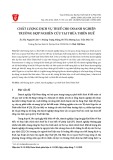


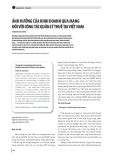
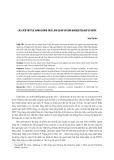
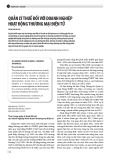
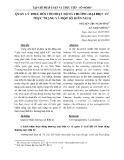
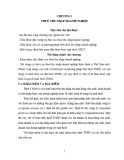
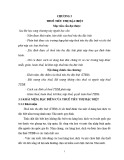














![Sổ tay Thuế điện tử dành cho kế toán trưởng doanh nghiệp [Mới nhất]](https://cdn.tailieu.vn/images/document/thumbnail/2025/20251017/kimphuong1001/135x160/4621760667251.jpg)
